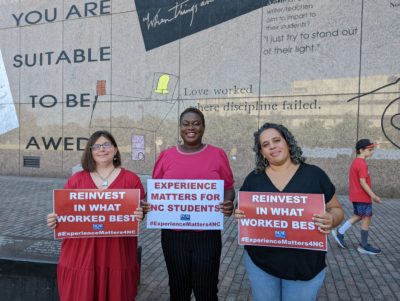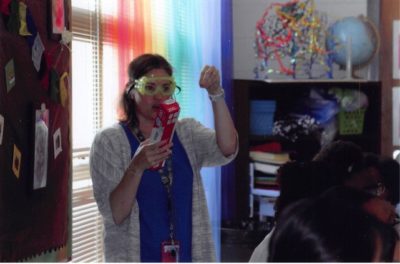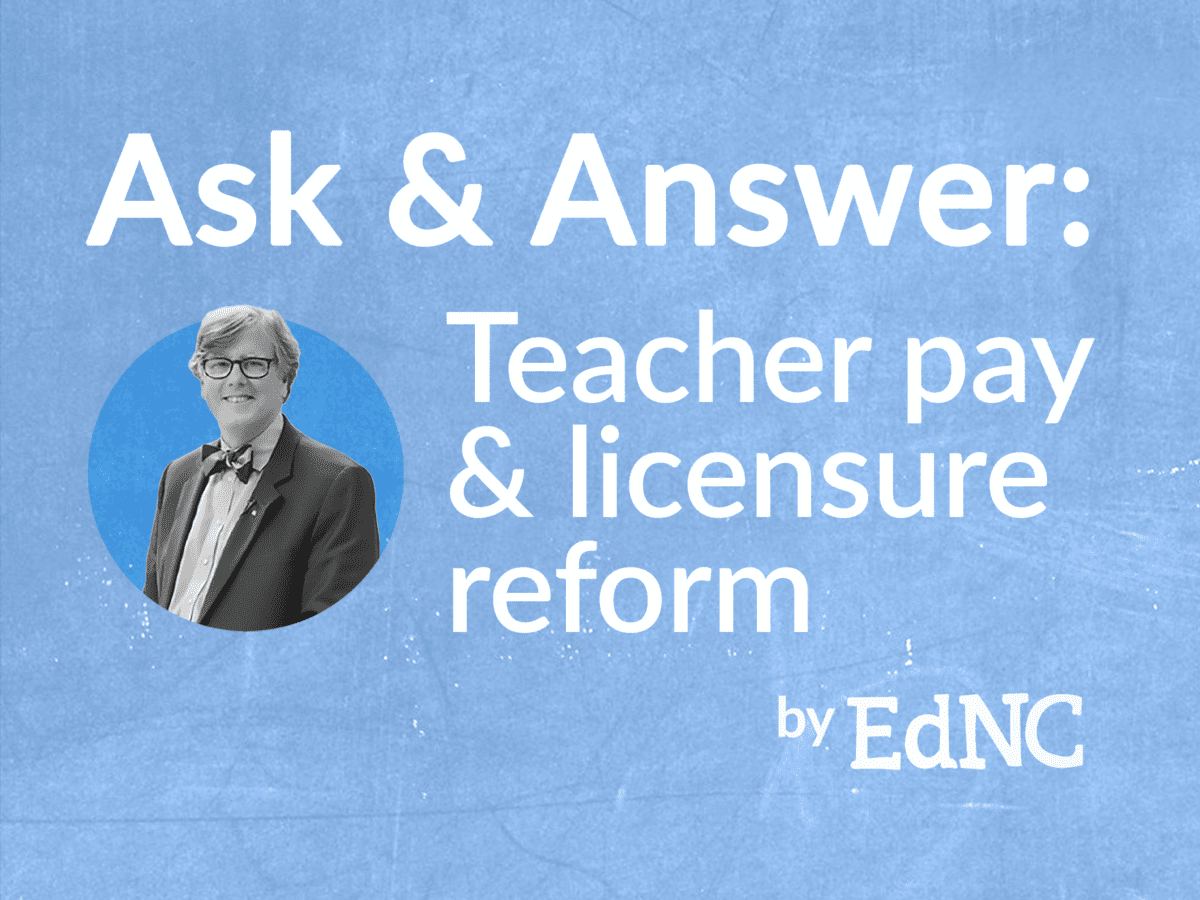
|
|
For much of this year, the Professional Educator Preparation and Standards Commission (PEPSC) has been working on a proposal that would overhaul how North Carolina teachers are licensed and paid.
Ahead of the commission’s next meeting on Oct. 13, we sat down with Chair Van Dempsey to answer some of the most frequently asked questions we’ve been getting from readers.
Under North Carolina’s current system, teachers are paid based on their levels of experience. The new proposal would introduce different levels of licensure and corresponding pay, ranging from apprentice teachers to advanced leadership roles.
Dempsey, who is also the dean of UNC-Wilmington’s College of Education, said he wants this plan to improve outcomes for both students and teachers.
“Why is North Carolina doing this? Because we can build that,” he said. “And if we want a profession that we know is rewarded, supported, resourced, structured in a way that North Carolina has the teachers it needs and the teachers it wants, we can do that.”
Click through the slides below to see the most recent draft of the proposal.
Keep reading to find out answers to who will be affected by this proposal, what could change for classroom teachers, and what comes next.
Who will be affected by the teacher licensure and pay reform?
This proposal only applies to classroom teachers. So if you’re an assistant principal, school counselor, or another role that isn’t a classroom teacher, your pay and licensure process will not change if this proposal goes into effect.
What are the different licensure levels, and what supports/pay do they receive?
You can view basic information about the different license levels in the infographic below. A more detailed outline of the various requirements for each license level is in the slideshow at the top of this article.
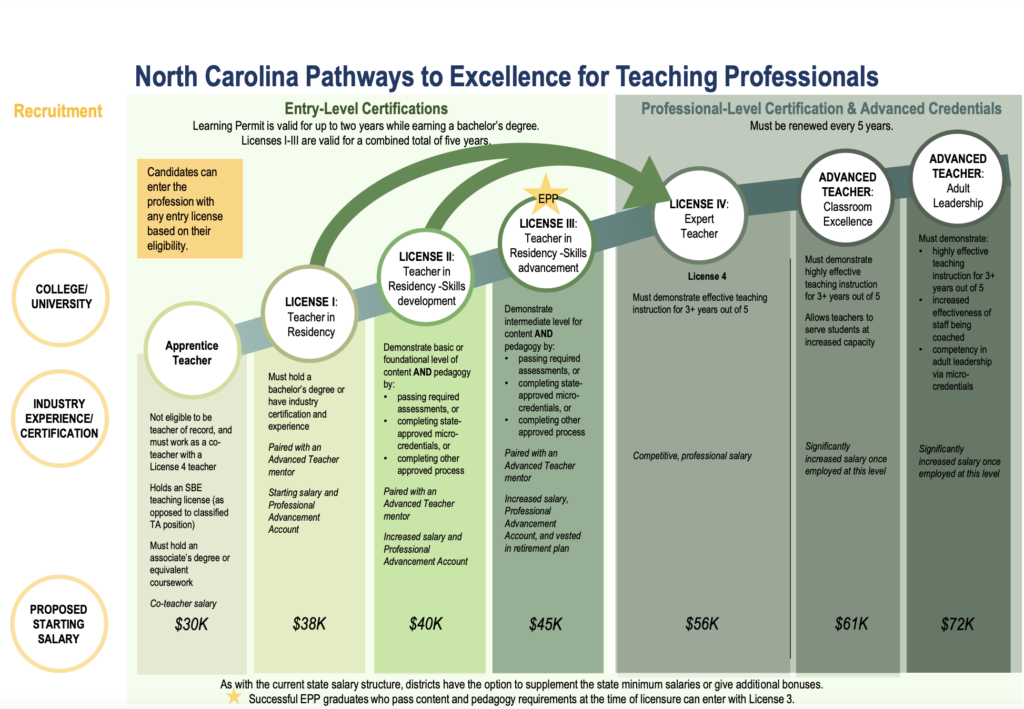
As teachers advance through different licenses, they have access to mentoring, professional development, and stipends. For example, License III teachers would get a weekly peer review from an advanced teacher.
How should a teacher think about what their license level would be?
A current teacher can get a sense of where they would fall by looking at their current license, Dempsey said. This means looking at whether you’re fully licensed or have a residency license, for example.
Under the proposal, a recent graduate from an educator preparation program should fall under License III. Someone coming into teaching from a different career might start out in License I. The general population of current classrooms teachers would likely fall under License IV, he said.
How much money would I make under the proposed teacher pay reform?
Each of the license levels under this draft proposal have a corresponding starting salary. Then once you get into License IV under this draft, years of experience and things like National Board Certification are added to the mix.
Dempsey explained that for teachers currently licensed, whether they already live in North Carolina or are coming from another state, you can look at your current license level and level of experience to determine what your salary would be if the proposal going into effect.
Take a look at the table below. The current salary schedule is on the left, and the one being proposed by PEPSC is on the right.
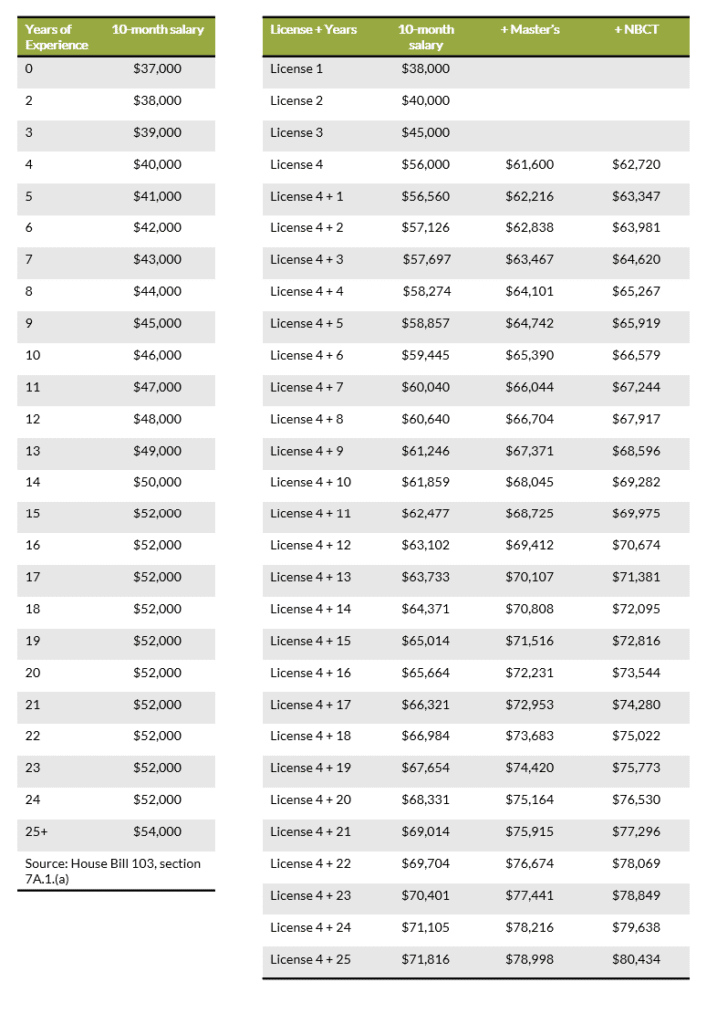
This proposed salary schedule could mean that educators earn hundreds of thousands of dollars more during the course of their career, compared to the current salary schedule.
There’s a lot to consider. If you’re already a full-time teacher and have a couple years of experience, you’d likely qualify for a Level IV license. The base salary for that is $56,000 with a 1% yearly increase. If you have a master’s degree, add 10% on top of that. And if you have National Board certification, you’d get a 12% raise on top of your base salary.
Here’s an example: Let’s say you’re a teacher with 7 years of experience and a master’s degree. Under this proposal, you would make $66,044.
If you’re a teacher-in-training or have an associate degree, you may be eligible for an apprentice teacher license or a license between Levels 1 and 3. The salary range for those is $30,000 to $45,000. Where you fall in that range depends on your education, credentials, and performance on a number of metrics.
Dempsey said a hold harmless provision is expected, meaning currently licensed teachers wouldn’t get a pay cut if this proposal goes into effect.
“I’m not hearing resistance to that,” he said.
Has PEPSC discussed this proposal’s implications on CTE teachers?
Dempsey said the commission is still working on a recommendation for this.
“(The Preparation and Entry Subcommittee) has talked on multiple occasions about how there are conditions that are unique to CTE teachers that you wouldn’t see in a content area teacher or in elementary, middle, secondary,” he said, “and that the model has to be attentive to the expectations for a CTE teacher, and likely would be different than what we would see for teachers and other certification areas.”
“We understand that we will need to be clear about what the pathways are for CTE teachers,” he explained further.
As for what that evidence of practice could look like for CTE teachers, he said PEPSC is still working on a specific recommendation, but it could include things like years of experience in the industry.
How will teacher effectiveness be measured?
Teachers advance through and maintain the various levels of licensure by demonstrating effectiveness, or a positive impact on student learning.
If you look at the draft model at the top of this article, you’ll see an outline of the different ways teachers will be evaluated at each license level. This can include things like microcredentials, National Board Certification, observations, student test scores, and other tools not yet developed.
Dempsey emphasized that this portion of the model is about “evidence of impact on student learning.” He said one of the most important things is understanding the complexity of teacher practice and translating that into adequate professional development and evaluation of student learning.
That’s why there are multiple evaluation methods in the proposal, he said.
“You want instruments that are valid and reliable, that help to inform the teacher,” he said. “The purpose is to inform the teacher practice so that we can have the most positive impact on students that we can, and then how to translate that into the knowledge base that is used in the profession.”
He said he understands there are concerns that these measures could be used in negative ways.
“As a chair of PEPSC, as a dean, as an educator, as a citizen who’s had kids in public schools, if you’re developing formative tools, they should not be used for those purposes in isolation of some other form of evidence, or some other reason to believe that you’re at a critical point in a teacher’s skill and ability and capacity.”
What role does EVAAS play in this proposal?
The Education Value-Added Assessment System (EVAAS) is one measure included in the proposal that teachers could use to demonstrate an impact. But Dempsey emphasized that is just one option for teachers out of several, with the goal of adequately capturing the teacher’s practice.
“In an effective infrastructure for understanding teacher practice and its impact, it cannot come down to one factor,” he said. “That is bad assessment.”
Not all teachers have EVAAS scores, too. That’s where the other measures, such as observations, come in.
What is the timeline for this proposal?
This proposal still has a long way to go.
Right now, PEPSC still has the proposal, Dempsey explained. He said depending on how members’ questions are addressed at next week’s meeting, the commission could vote on the proposal as soon as November.
Once PEPSC approves the draft proposal, they will present their recommendations to the State Board of Education. From there, the State Board could take additional time to deliberate on and edit the proposal before taking its final vote.
Dempsey said he hopes that once the proposal is in the State Board’s hands, that the Board and PEPSC can collaborate on fine-tuning some of the details of the proposal and how it will be implemented.
The proposal then has to pass through the state legislature.
Until then, PEPSC is still actively working on the proposal, and Dempsey is encouraging people to send feedback and recommendations. You can send feedback to pathways.feedback@dpi.nc.gov.
Recommended reading

